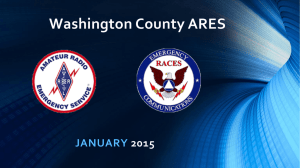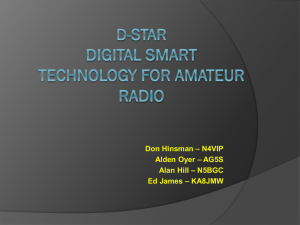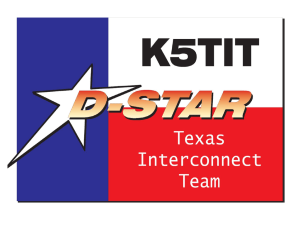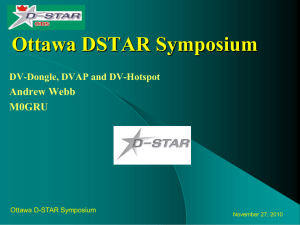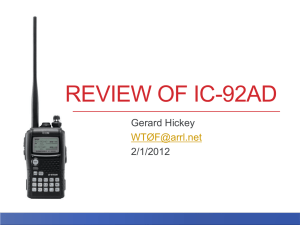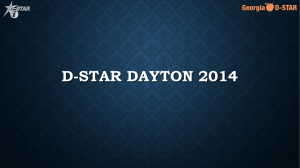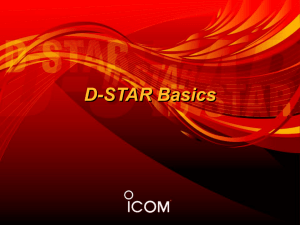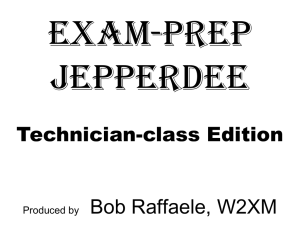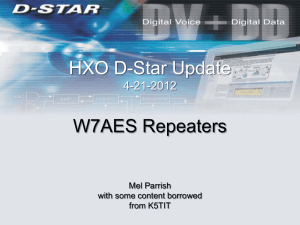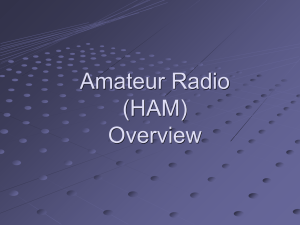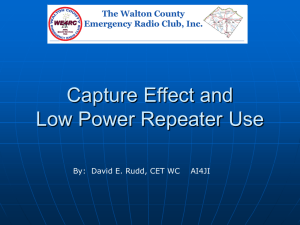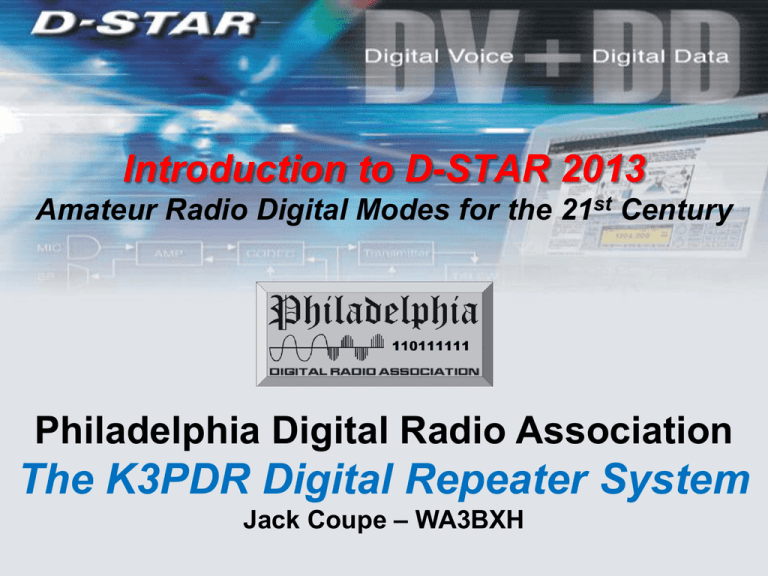
Introduction to D-STAR 2013
Amateur Radio Digital Modes for the 21st Century
Philadelphia Digital Radio Association
The K3PDR Digital Repeater System
Jack Coupe – WA3BXH
PDRA Overview
Formed in 2007. PDRA’s membership now includes over 30 amateurs who explore
new digital radio modulation technologies to communicate both voice and data.
The club currently operates coordinated repeaters on 440/445.18125 mHz and
146.61/01. The repeater uses the D-Star format and is located at the Mermaid Lane
tower in Wyndmoor, Montgomery County, PA at the Montgomery
County/Philadelphia border. Tx-Rx antennas are shared with a commercial
operation and UHF antennas are located near the top of the tower at
approximately 550 feet agl, and over 900 feet amsl while the VHF is at 300 feet.
We hope to establish 1.2 gHz. DD and DV links in the future as funds permit
The club supports many other amateur radio organizations to provide training and
awareness of emerging digital modes as well as technical support to amateurs
becoming involved with digital communications and strives to be the preeminent
amateur organization promoting amateur digital radio operations.
440 mHz. Repeater Mobile Coverage Area
Throughout history
Amateur Radio
Operators have
established a
reputation for public
service
communications
And, for Disaster and Emergency
Relief Efforts…
D-STAR and Amateur Radio
Operators can provide the
“first” and “last” mile
communications to enable
an effective emergency
response in Disaster
communications
Amateur Radio operators can now put
D-STAR’s Hi-Speed data capabilities to
work supporting their “served agencies”
with IT tools they understand and expect…
Email
Spreadsheets
File Transfer
Graphics
Web browsing
Maps
For EMCOMM Operations, D-STAR can link
Field Shelter and EOC Staff with Digital Data
• Email in the Field
• Site to Site Digital
Communications
• Keyboard to Keyboard
text messaging
• Fully HIPPA compliant
D-STAR can bridge the Gap in
Disaster Communications
with…..
•
•
•
•
•
Damage Assessment
Wide Area Networking
Shelter Management
Field Digital Data (Photos, etc)
Visual Asset Tracking
Damage Assessment
By utilizing D-Star’s High Speed
Digital Data, public safety
management members can see
exactly what their in-the-field
staff sees during windshield
surveys, providing a useful
tool for real-time on-scene
visuals
Wide Area Networking
Compliments existing
emergency management
networks – covers miles
and not just meters
Embedded Position
information with links to
Digital Maps, Charts and
more
Shelter Management
D-Star enables shelters to share
vital information digitally….
• Inventory, medical supplies,
fuel supplies, and water
availability, bed counts, etc.
• Logistics and Coordination
• Staff and Schedule
Visual Asset Tracking
D-STAR integrates GPS information automatically
with normal Tactical Communications….
Position is included with
every Voice transmission
• Real time map plots on
computers running Automatic
Position Reporting (APRS)
software
• Allocate efficiently at a glance
Why is D-STAR interesting?
•
Digital packet carries both Digital Voice and concurrent Data Stream
•
Radios automatically transmit call sign along with the voice
communications, and it is displayed on all receiving stations screens
•
No need to Voice ID since the call sign is sent with each transmission
•
GPS location transmitted along with voice communications
•
Wide Area Networking with Digital Data (DD) that can be sent in highvolume while traditional modes are slow
•
Can dispatch assets accurately and place data in the hands of those
who need it the most – fast image, text and document data exchanges
(Even though you don’t need to voice ID to be legal on D-Star, it is still a good operating
practice to do so)
And for so many Amateur Radio Uses
Think of how these same D-Star features can be used in your
other Amateur Radio communications support
• Parades
• Walk-a-thons
• Bicycle marathons
• Major event coordination
D-STAR is now the fastest growing
new technology in Amateur
Radio!
D-Star History
• Began as a government funded project by the
Japanese Amateur Radio League for mobile
digital communications.
• Provides Digital Smart Technology for Amateur
Radio
• Plenty of additional information is available on
internet especially at Icom and JARL sites
• D-Star is an open standard, available for any
amateur or manufacturer. Only the codec
(AMBE vocorder) is proprietary and licensed.
D-Star History – cont.
• 1999 - Funded by the Japanese
government and administered by the
JARL, development of protocols for a new
digital technology for amateur radio.
• 2001 - Protocols are published by JARL
• 2002 - Icom offers first commercial radios
Typical D-STAR Configuration
Gateway Overview
D-Star SystemsTopography – Peer to Peer!
Sys
1
Sys
2
Sys
6
Trust
Server
Sys
3
Sys
5
Sys
4
D-Star’s Protocol
•
•
•
•
Header is not encrypted
GMSK modem sees header fields & passes them to PC
DV Payload created by codec in AMBE chip
HotSpot GMSK modem passes DV payload as a stream of bits
without decoding
Four call signs used – You will see many examples
MYCALL – Call sign of the originating station – your own call
spec calls this “Own Callsign”
URCALL – Call sign of the desired target station, or CQCQCQ
spec calls this the “Companion Callsign” – can be a port !
RPT1 – Call sign (& port) of the originating (input) repeater
spec calls this the “Departure Repeater Callsign”
RPT2 – Call sign & designator of the gateway (or cross band port)
spec calls this the “Destination Repeater Callsign”
(A bit misleading for Gateway calls)
Gateway Operations
Registration
Not required for local use only
Contact your local repeater administrator to get registered :
Philadelphia: Stan Hess N3KDA or Mike Campbell, KB3IKP
See K3PDR Yahoo Group files section for more information
No private conversations both ends hear all
User linking / routing vs. site linking
Not all users on site can participate - Opportunity for confusion!!!
Each User determines the route his transmission takes in system
Program Your Radio Ahead of time!
Multiple Ways to Traverse Gateway
User-Specific call
“Follow-me Roaming” – Example: specific call to W3ZZZ
Sync Timing may cause delays when user switches (10 minutes typ)
Also, this type of call will typically interrupt an ongoing local QSO
Port call
Example
- URCALL = ‘/K5TIT’
Specific routing of port call – defaults to Port ‘A’
Port-specific call
Example – URCALL = ‘/K5TIT C’ be sure the C is in the 8th position
This type of call is “polite” to local QSOs. It will typically not interrupt
D-Plus Linking
D-Plus Software
• Developed by Robin Cutshaw AA4RC
• Provides “linking” capability to the gateways similar to how amateur
radio operators link analog repeaters.
• Provides the ability to create D-STAR-only reflectors and to create
virtual connections between repeaters and between repeaters and
reflectors.
• Since its inception, it has grown to be a portal for DVDongle users (a
USB AMBE codec)
• Allows static information such as text, prerecorded AMBE audio and
Icom front panel messages to be generated by individual repeaters
Gateway Reflectors
• Reflectors allow the interconnection of multiple
repeaters to form D-Star networks
• Can be user or administrator controlled
• Requires all users to program radios for gateway
operations
• If you initiate linking operation, it is important to
clear the reflector following operations
• www.dstarinfo.com is a great resource to use!
WWW.D-STARUSERS.ORG
Future Directions
• Open D-STAR Projects have a Big Impact !
• The Open D-Star Gateway “ODG” allow us to
define our own configurations / ODG by AA4RC
– Try this
• UR: K3PDR E RPT1: K3PDR B RPT2: K3PDR G
• You’ll Get an audio playback – Great for troubleshooting
• Home Brew D-Star & Experimentation
– Check out AE4JY’s DVX Transceiver
• www.moetronix.com
Questions ?
Our sincere thanks to Ron Shaffer - W4VM and Bob Wiseman WB3W ARRL Section
Emergency Coordinator for their permission to use some Power Point Slides and to Jim
Moen – K6JM for his presentation on hot spots. Additionally to Pete Loveall - AE5PL of
the Texas Interconnect Team, and our great friends Fred Varian – WD5ERD of the
Texas Interconnect Team and Icom Support, Ray Nowack, Icom Amateur Products
Manager and Brian Rode - NJ6N for help and support over the years.
Online Discussion Forums
http://groups.yahoo.com/group/dstar_digital/
www.K5TIT.Org/Forum
Other D-STAR Web Sites
www.D-STARUsers.Org
www.dstarinfo.com
www.aprs-is.net/dstartnc2.htm
http://groups.yahoo.com/group/k3pdr
jcoupejr@aol.com
jcoupejr@coupecommunications.com
PDRA meetings are held on the 1st non-holiday Monday
at Ambler Community Ambulance Association, 1414 E.
Butler Pike, Ambler, PA. Meetings begin at 19:30 hours
and generally last about 2 hours. All are welcome. A
local net is held on non-meeting Monday evenings at
20:00 hours local. We also participate in the Mid-Atlantic
Regional D-Star net on Tuesdays at 19:30 hours.

